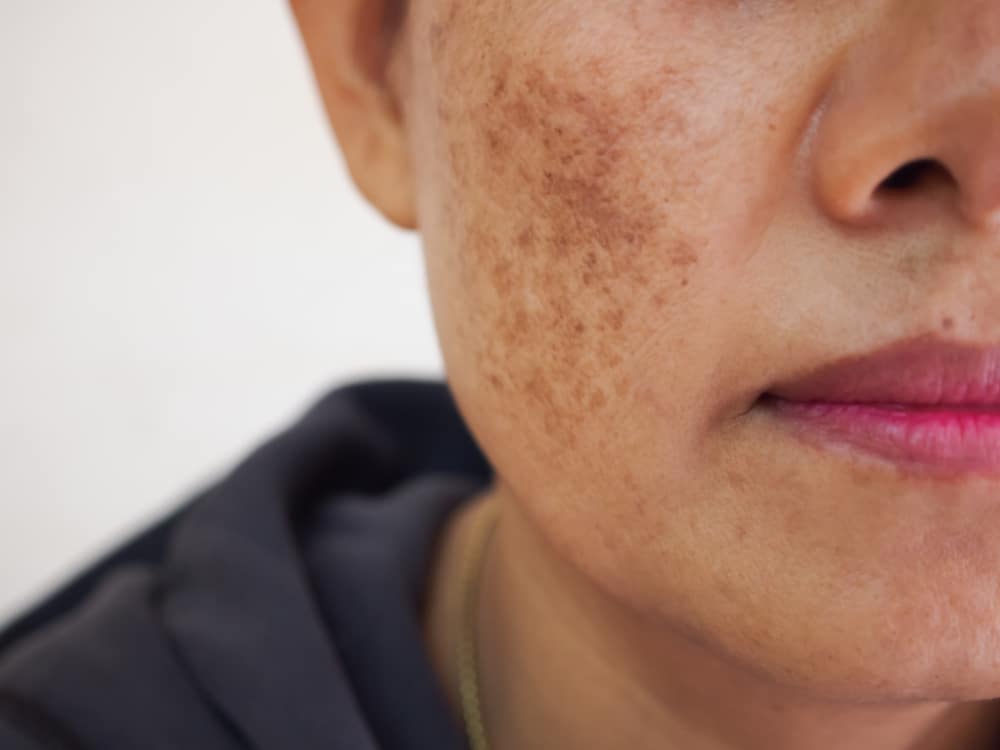Are you starting to notice greyish-brown spots or patches on your skin? This could be melasma, which often appears on our skin after years of sun exposure. But you don’t have to tolerate these changes as a part of aging.
Dr. Riehm and her team offer several options at Skin Deep Laser MD in Fort Worth, Texas. Our treatments include PicoSure® laser sessions to even out your tone and eliminate dark patches. To learn how you can benefit from this laser treatment, call the office or book an appointment online.

What Is Melasma?
Melasma is a common skin condition characterized by brown or grayish-brown patches on the skin. It commonly occurs in women, although men can also develop these characteristic patches.
Melasma typically appears on the cheeks, forehead, chin, bridge of the nose, or upper lip. In some cases, it can also affect areas like the forearms and neck, especially if they have had a lot of sun exposure. These patches can vary in size and shape, often creating an uneven skin tone that can be cosmetically concerning.
Causes of Melasma
The exact cause of melasma isn’t entirely understood. It occurs when your skin's melanocytes (pigment-generating cells) are overactive and produce too much pigment. This may be due to sun exposure, hormone changes, or certain skin care products.
Women develop melasma more often than men, likely due to hormones. It can often occur with pregnancy and is known as the “mask of pregnancy.” People with darker skin tones are also more likely to develop melasma, and the skin discoloration seems to have a genetic component.

Melasma Treatment Options
Treating melasma often requires a combination of therapies specific to your skin type and condition. Here are some of the most recommended options:
- PicoSure Laser Treatments: Targets and breaks down pigment particles, providing noticeable results with minimal discomfort.
- Topical Treatments: Prescription creams containing hydroquinone, tretinoin, or corticosteroids can lighten dark patches.
- Chemical Peel: Uses acids to remove the outer layer of skin and reduce the appearance of melasma.
- Microneedling: Involves using fine needles on the skin, which can help reduce pigmentation and improve skin texture.
- Fractional Laser Resurfacing: Creates micro-injuries in your skin to promote the natural healing process, reducing pigmentation and improving skin texture.
- Intense Pulsed Light (IPL) Therapy: Uses light energy to target and reduce skin pigmentation.
- Oral Medications: Can help regulate hormones and suppress melanin production
How Does PicoSure Treat Melasma?
The PicoSure laser uses different wavelengths of light to target each level of discoloration in your melasma. The darker-pigmented skin absorbs the light energy, and the color particles are broken down and then disposed of by your body’s natural cleansing processes.
The results of PicoSure laser treatments are visible right after treatment, but you’ll see continued improvement with regular follow-up sessions.
Why Choose Skin Deep Laser MD?
Dr. Laura Riehm and her team at Skin Deep Laser MD are here to help you look and feel amazing. Whether you're looking to improve your skin tone, reduce wrinkles, or tackle melasma, Skin Deep Laser MD uses the latest FDA-cleared equipment to ensure you get the best results.
Dr. Riehm, a Fort Worth native, personally oversees all treatments, bringing her extensive medical training and passion for aesthetics to every patient. With a background in anesthesiology, she understands the importance of safety and effectiveness. From PicoSure® laser treatments to Botox® and dermal fillers, you can trust Skin Deep Laser MD to provide top-quality care.
Melasma Q & A
Does PicoSure Laser Treatment Hurt?
The PicoSure laser can cause mild discomfort, but most people tolerate treatment quite well. The “picosecond” technology means treatment times are faster than other common lasers, so you spend less time under the laser energy.
You may have some pinkness or redness to your skin immediately following treatment, but this discoloration will fade within a few hours after treatment.
How Much Downtime Will I Need Following the PicoSure Treatment for Melasma?
There’s no need for days or weeks of recovery following PicoSure laser treatment. You can return to your normal schedule immediately. You should take extra special care to wear sunscreen following the laser treatment, as your skin is temporarily more sensitive. Wearing sunscreen on a daily basis is a good practice anyway.
What Can I Do to Prevent Melasma?
Preventing melasma involves adopting a few protective habits and making smart skincare choices. Here are some key steps you can take:
- Use Sunscreen Daily: Apply broad-spectrum sunscreen (SPF 30+) every day, even on cloudy days.
- Wear Protective Clothing: Use hats, sunglasses, and cover-up clothing to shield your skin from UV rays.
- Avoid Peak Sun Hours: Stay out of the sun between 10 a.m. and 4 p.m.
- Be Mindful of Hormones: Discuss hormonal medications with your doctor to understand the risks.
- Choose Gentle Skincare Products: Avoid harsh chemicals that can irritate your skin.
Is Melasma Permanent?
Melasma can be a long-term condition, but it is not necessarily permanent. With appropriate treatments and preventive measures, many people see significant improvement or even complete resolution of their melasma. However, ongoing maintenance and sun protection are often needed to prevent recurrence.
Can Melasma Go Away on Its Own?
In some cases, melasma can fade on its own, especially if it was triggered by pregnancy or hormonal changes that have since resolved. However, this process can take a long time, and many people seek treatment to speed up the clearing of the dark patches.
Are There Any Side Effects From a PicoSure Treatment?
PicoSure laser treatments are generally well-tolerated, but you may experience mild side effects such as temporary redness, swelling, or a slight tingling sensation in the treated area. These side effects typically resolve within a few hours to a couple of days. It's important to follow post-treatment care instructions to minimize any discomfort.
How Many PicoSure Treatments Will I Need?
The number of PicoSure treatments required varies depending on the severity of your melasma and your skin's response to the laser. Typically, patients see significant improvement after two to four sessions spaced several weeks apart. Dr. Riehm and her team will come up with a schedule that fits your needs.
Learn About Melasma Treatment Options
Dealing with melasma can be frustrating, but treatment is available. At Skin Deep Laser MD, we want to give you clear, beautiful skin with our advanced PicoSure laser treatments.
If you're ready to explore your options and see how our team can help, give us a call at 817-263-7546 or book an appointment online. Let's work together to bring out your natural beauty and boost your confidence.

